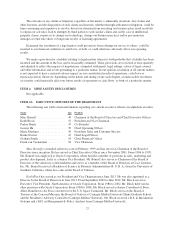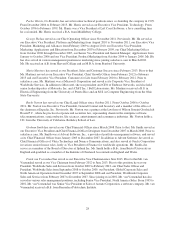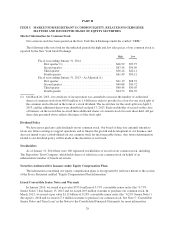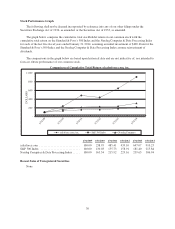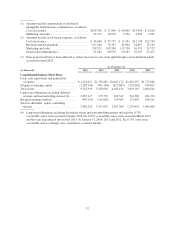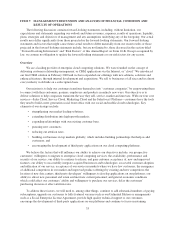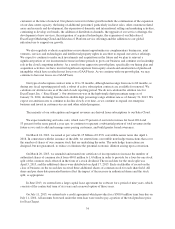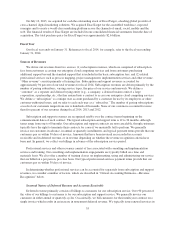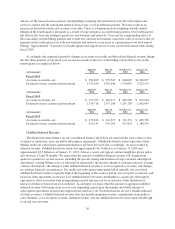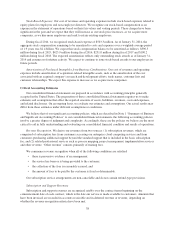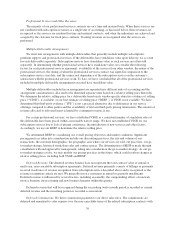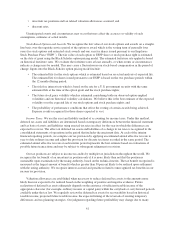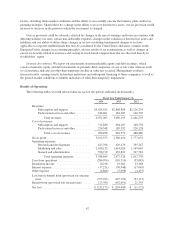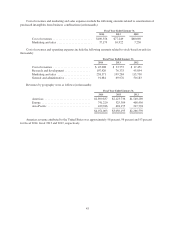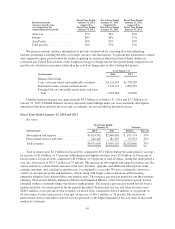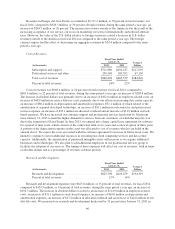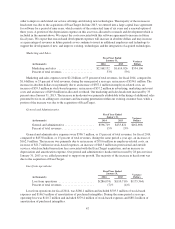Salesforce.com 2014 Annual Report Download - page 41
Download and view the complete annual report
Please find page 41 of the 2014 Salesforce.com annual report below. You can navigate through the pages in the report by either clicking on the pages listed below, or by using the keyword search tool below to find specific information within the annual report.Cost of Revenues and Operating Expenses
Cost of Revenues. Cost of subscription and support revenues primarily consists of expenses related to
hosting our service and providing support, the costs of data center capacity, depreciation or operating lease
expense associated with computer equipment and software, allocated overhead and amortization expense
associated with capitalized software related to our services and acquired developed technologies. We allocate
overhead such as information technology infrastructure, rent and occupancy charges based on headcount.
Employee benefit costs and taxes are allocated based upon a percentage of total compensation expense. As such,
general overhead expenses are reflected in each cost of revenue and operating expense category. Cost of
professional services and other revenues consists primarily of employee-related costs associated with these
services, including stock-based expenses, the cost of subcontractors and allocated overhead. The cost of
providing professional services is significantly higher as a percentage of the related revenue than for our
enterprise cloud computing subscription service due to the direct labor costs and costs of subcontractors.
We intend to continue to invest additional resources in our enterprise cloud computing services. For
example, we have invested in additional database software and we plan to open additional data centers and
expand our current data centers in the future. Additionally, as we acquire new businesses and technologies, the
amortization expense associated with this activity will be included in cost of revenues. The timing of these
additional expenses will affect our cost of revenues, both in terms of absolute dollars and as a percentage of
revenues, in the affected periods.
Research and Development. Research and development expenses consist primarily of salaries and related
expenses, including stock-based expenses, the costs of our development and test data center and allocated
overhead. We continue to focus our research and development efforts on adding new features and services,
integrating acquired technologies, increasing the functionality and security and enhancing the ease of use of our
enterprise cloud computing services. Our proprietary, scalable and secure multi-tenant architecture enables us to
provide all of our customers with a service based on a single version of our application. As a result, we do not
have to maintain multiple versions, which enables us to have relatively lower research and development expenses
as compared to traditional enterprise software companies.
We expect that in the future, research and development expenses will increase in absolute dollars and may
increase as a percentage of total revenues as we invest in building the necessary employee and system
infrastructure required to support the development of new, and improve existing, technologies and the integration
of acquired businesses and technologies.
Marketing and Sales. Marketing and sales expenses are our largest cost and consist primarily of salaries and
related expenses, including stock-based expenses, for our sales and marketing staff, including commissions,
payments to partners, marketing programs and allocated overhead. Marketing programs consist of advertising,
events, corporate communications, brand building and product marketing activities.
We plan to continue to invest in marketing and sales by expanding our domestic and international selling
and marketing activities, building brand awareness, attracting new customers and sponsoring additional
marketing events. The timing of these marketing events, such as our annual and largest event, Dreamforce, will
affect our marketing costs in a particular quarter. We expect that in the future, marketing and sales expenses will
increase in absolute dollars and continue to be our largest cost.
General and Administrative. General and administrative expenses consist of salaries and related expenses,
including stock-based expenses, for finance and accounting, legal, internal audit, human resources and management
information systems personnel, legal costs, professional fees, other corporate expenses and allocated overhead. We
expect that in the future, general and administrative expenses will increase in absolute dollars as we invest in our
infrastructure and we incur additional employee related costs, professional fees and insurance costs related to the
growth of our business and international expansion. We expect general and administrative costs as a percentage of
total revenues to either remain flat or decrease for the next several quarters.
37


